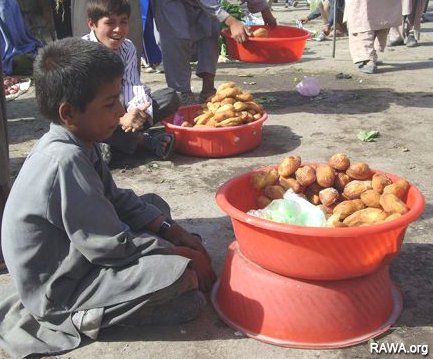AFP, June 9, 2007
Kabul's beggar children working the streets
There are 50,000 to 60,000 street children in Kabul
Sardar Ahmad
KABUL -- Shakir sits at the side of the road, his head buried in his hands, 10 broken eggs melding with the dust at his feet.
"I was selling eggs. I fell over. My eggs smashed," the five-year-old whimpers quietly. "I have lost 50 afghanis ($1), my mother will kill me."
It is a routine the child has been playing out all over Kabul for months and now some residents are wise to it.
"He does this every day," smiles a resident, handing the boy a chocolate bar as he walks past.
Each day Shakir invests the equivalent of a dollar to buy eggs that he drops on a dirty footpath. He then sits miserably in front of them and tells his story in the hope of attracting donations.
His brother, who looks about two years older, is never far away, ready to take the collection, fend off suspicious enquirers, and chase away other street children also looking for some pickings.
Shakir's trick reflects the competitive world of child beggars in Kabul, a city clogged by a population of around 4 million people that exploded after the 2001 fall of the Taliban regime led exiles home and jobseekers to the capital.
According to surveys by the UN children's organization, UNICEF, there are 50,000 to 60,000 street children in Kabul, said the UN Afghanistan spokesman Aleem Siddique.
Aschiana, a non-governmental organization that supports and educates children working on the streets, puts the number higher and says it has almost doubled in the past two years.
"In 2005 there were 37,000 children working on the streets," said program manager Nazar Mohammad.
- 54 percent of Afghan children are born stunted (6,500 maternal deaths per every 100,000 live births)
- The fertility rate in Afghanistan is the world's second highest at 7.5 children per woman, according to UNDP's 2006 Human Development Report.
"But now, according to new surveys, there is nearly 70,000 of them working," he says.
Most of them have lost one or both of their parents, often in the war that has long plagued this country, and are their families' only breadwinner, according to Afghanistan's Independent Human Rights Commission (AIHRC).
"A study carried out by AIHRC found a majority of 18,000 street children interviewed indicated that they have lost one or both of their parents," commissioner Nader Nadery says.
The children work alongside Kabul's adult beggars, who include men who lost limbs in the war and women hidden beneath filthy burqas and holding still infants to soften passing hearts.
Some of the children rap on the windows of cars stopped at traffic jams, demanding the occupants buy chewing gum, Dari-English dictionaries, maps in Russian, or old copies of US military magazines.
Others cling to vehicles to wipe their windows with filthy rags; pretty little girls just smile and ask for tips.
Mohammad Aman trades on Afghan superstition by waving about a black and acrid smoke made by from burning "espand," the seeds of a wild plant. The smoke is believed to drive away evil spirits.
"My father died fighting the Taliban," says the grubby boy, aged 11. "We are six people at home," he adds, showing the number on coal-blackened fingers.
"Me and my brother have to work," says the child, dressed in rags and working on a busy road outside the up-market shopping area of Shar I Nau. The boys make about $4 a day - enough to buy food, he says.
Mohammad, from Aschiana, says the issue of street children has been neglected amid the many problems facing the destitute country.
"The government has not done much," he said at one of the group's six centers where art classes reflect the war in which most Afghan children were raised, one painting showing a bombed-out and roofless classroom.
One of the government's successes, however, is that it has increased by five-fold the number of school enrollments since the Taliban fell nearly six years ago, according to British-based charity Oxfam.
About 6 million children are in school, still only half of all school-age children in the country, the education ministry says.
The UN's Siddique says tackling the growing number of street children in Kabul needs more than just "aid money."
Nearly $13 billion has been spent since 2001, including on security with a Taliban insurgency unabating.
"We need to support parents who are currently not sending their children to school for financial or cultural reasons," he says.
Afghanistan has one of the lowest literacy rates in the world, with about half of men and 20 percent of women able to read and write. Some poorer families want their children to work instead of go to school.
"This is not an issue solely related to money - there is a need for cultural change where parents value the importance of education for all children - both girls and boys," Siddique says.
In the meantime, little Shakir will continue with his broken eggs.
"I just fell over and my eggs smashed," he insists quietly.
Characters Count: 6616

 (
(